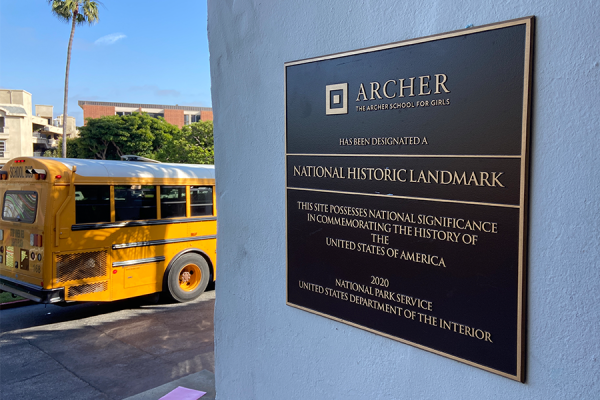Do uniforms really create socioeconomic equity?: Designer items while in uniform
Photo credit: Cydney Johnson
One of the most prominent brands on campus is Gucci. This Archer student is wearing Gucci Ace leather sneakers, which are listed on the Gucci site for $590.
According to the National Center for Education Statistics, almost half of all high school students wear a school uniform. Uniforms have grown in popularity annually since 1996, when then-president Bill Clinton said that school uniforms would give students the opportunity to “evaluate themselves by what they are on the inside instead of what they’re wearing on the outside.”
To explore uniform policies and equity, the Oracle interviewed a professor at the University of Nevada, Reno College of Education, in addition to students at Archer and beyond.
What Research Says
Some claim that school uniforms improve student achievement and behavior by decreasing crime, reducing bullying and peer pressure and helping students focus. In 2013, Dr. Jafeth Sanchez and George “Gus” Hill studied the opinions of middle school students one year after the implementation of school uniforms. Their findings concluded that discipline, gang activity and bullying decreased with the implementation of uniforms. The majority of students agreed with the statement, “I still have my identity when I wear a uniform.” In general, when students were asked to reflect on specific benefits of uniforms, the majority stated that they preferred uniforms. Their findings concluded that the perceived benefits of school uniforms were accurate.
In an email interview, Sanchez reflected on ways her research could be taken further by addressing nuances to their data, including schools with students of high socioeconomic status and schools with low gang activity. While her research did not include high school students, she believes that high-school level results would be consistent with the results of the middle schoolers.
“For example, it could potentially show unique differences from students from underrepresented groups, such as the Latinx population,” she wrote. “There could also be quite a few group differences by school level. I would anticipate that, perhaps, more benefits would occur for freshmen students than for seniors. I would also anticipate unique differences by gender, with females indicating there are more benefits to wearing them. The only way to know is to have a large sample size at that level, though.”
Though Sanchez is not in favor of or against uniforms, she believes that school administrators should evaluate the costs and benefits before implementing policies to implement or remove them.
“As part of the evaluation, students’ voices are often forgotten,” she wrote. “Their views need to be included to then make the most appropriate decision under each unique school context.”
Within the Archer Community
Many schools, including Archer, do not restrict the brand of shoes or accessories the students can wear. Stricter school rules limit the color of shoes, but students are still able to wear designer shoes and accessories. In response to Sanchez’s findings that school uniforms create more equality among students, senior Andrea Campos partly agreed.
“I think people wear [expensive items] either because they do want to show off their newly bought shoes or necklace to others or because they genuinely love the look and have the facilities to buy something high-end,” she said. “It is either a way to show off your wealth, or I think it can also be something that is innocent and not meant to be boastful.”
In a survey sent to all students at the Archer School for Girls, 30.4% of respondents said that they “always” notice other students wearing designer items at school, while another 30.4% said they “sometimes” do. 28.6% of respondents said they “often” do. 9.3% of respondents said they “rarely” notice other students in designer wear, and only two of 161 respondents said they have “never” noticed other students in designer items while at school.
The survey included an optional space for students to answer the question: “How do you feel about people wearing designer items on Archer’s campus?”
“I definitely think that seeing designer clothing at school would make students who do not have the means to buy the same things uncomfortable. It makes students feel left out because they cannot keep up with the ‘trends,’” one student wrote. “I remember really becoming aware of designer items in sixth grade at Archer, and thinking back I am in shock that 12-year-old me was spending my time wanting a Valentino bracelet and Golden Goose shoes. I shouldn’t have been wasting my time with such trivial things like that, especially when I was so young.”
Junior Bella Bernhardt responded in the survey with a perspective similar to the previous one.
“Students should be able to wear what they want, but wearing designer clothes to school defeats one of the purposes of the uniform,” Bernhardt said. “If we’re all wearing uniforms to make us somewhat equal, even if it’s just the way we dress, students wearing designer sneakers, jackets, etc. with the uniform defeats its purpose.”

While the majority of respondents said they do notice others wearing designer items, 54% of respondents said they have “never” personally worn expensive designer items to school. The majority of responses indicated that students were neutral to the statement “It bothers me when I see other students wearing expensive designer shoes/clothes/accessories/backpacks at school.” Some students did not have any opinion at all on the matter. Over half of written responses included responses similar to “I don’t mind.”
“How people spend their money is their issue and if someone likes something they can show it. People prioritize different things,” one student said. “Personally I don’t care that much about clothes, so I focus on my hobbies and spend my money there, so it doesn’t bother me if someone is wearing expensive clothes.”

Now that classes have begun online using the platform Zoom, the uniform policy has been suspended. Since classes moved online, junior Bella Morgan said she has noticed “less designer wear” largely because students are wearing comfortable clothing during videoconferencing.
“If they wear designer clothes to bed, then we would see that on Zoom,” Morgan said, “[but] a lot of the time people that buy designer clothes want to show them off because they are more expensive, so they would be wearing the clothes to impress others more than for themselves.”
Interim Dean of Students Brianna Coughlan weighed in on the uniform policy and the goal behind implementing uniforms at Archer.
“I think the uniform policy is in place because it is an equalizer and it is a way to unify the student body. Everyone knows socioeconomic status varies all across the student body, and we do not need unnecessary distractions,” Coughlan said. “We want everyone to feel like they have an equal opportunity at an awesome education, and we’re there to focus on education.”
Though Coughlan sees how students might want to add their own “personal touch” to the uniform, she said she ultimately thinks students should not be wearing designer items.
“If you are going to wear a super expensive piece of jewelry, for example, that everyone could look at and know it costs X amount of dollars, I can see the perspective of that defeating the purpose of the uniform,” Coughlan said. “I think I personally would be on the side of the fence that it would defeat the purpose.”
Unless you are wearing name brand clothes, then people will not really care about what you are wearing. People mostly care about the really expensive items. — Annie Eckert
Beyond the Archer Community
The prevalence of designer wear in uniform is not limited to the Archer community. Marymount High School senior Annabelle Daly touched on her experience with uniforms.
“I really like being able to just roll out of bed and not worry about what I have to wear. Sometimes, there are people wearing designer clothes while in uniform, but I think that a lot of the time the brands are subtle,” she said. “Many times, people wear expensive jewelry or stuff like that where you can tell that the items are expensive, but not exactly which brand it is from.”
Does this social hierarchy exist within schools without uniform? Palisades Charter High School senior Annie Eckert reflected on her personal experience at a school without a uniform.
“It can be stressful because picking out something to wear can be tedious. There is definitely judgment when it comes to what you are wearing. People wearing rare Air Jordans, for example, will judge people who might be wearing regular running shoes,” she said. “Unless you are wearing name brand clothes, then people will not really care about what you are wearing. People mostly care about the really expensive items.”
Daly reflected on her experience with uniforms, and said “overall, it was positive.”
“I think uniforms are important to have, especially in this area of Los Angeles,” she said. “Even though people find ways to flaunt their wealth through wearing stuff like designer shoes, overall, uniforms still equalize and unify the student body through limiting the ways a student can show off their wealth.”

Cydney Johnson joined the Oracle as a staff reporter in 2019. She plays volleyball and she is also a member of Peer Support. During her free time she...














Larisa Carter • May 26, 2020 at 8:34 am
I enjoyed reading this article so much! Loved how you approached the issue from a variety of different perspectives and lenses. Thanks so much!
Ms. Chakravarty • May 25, 2020 at 9:59 pm
I agree with Ms. Gold– you’re going out on a high note with this article, Cydney! I like how you got perspectives from a variety of students, not just Archer students, and would love to hear what an even wider variety of students in LA think about wearing a uniform. You know it’s a good article when I leave thinking of more questions I’d like to answer!
Beth Gold • May 23, 2020 at 8:27 am
This is your best piece yet Cydney! You struck just the right tone of impartiality in addressing this question and your research provides good context to the benefits of uniforms in various communities. I am gratified to see that most respondents were in the neutral category and don’t place a lot of emphasis on designer labels. That wasn’t the case many years ago, so that makes me hopeful that Archer is moving in the right direction in what we as a school value.
Amelia Nathanson • May 21, 2020 at 4:41 pm
This is so interesting! Thank you for bringing this important topic to light!
Andrea Campos • May 21, 2020 at 2:37 pm
Wow Cydney. This article was very well written! Thank you for bringing up a topic that is not always talked about.